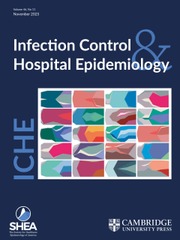No CrossRef data available.
Article contents
Enhanced Bundled Interventions to Reduce Surgical Site Infections for Patients with Congenital Cardiac Disease
Published online by Cambridge University Press: 02 November 2020
Abstract
Background: Surgical site infections (SSIs) among cardiothoracic (CT) patients are associated with high rates of morbidity and mortality. Data are limited regarding SSI incidence among pediatric patients undergoing primary reparative procedures for congenital cardiac disease. Published evidence on targeted interventions to prevent pediatric CT-surgery SSI is lacking. We aimed to establish standard metrics for measuring CT-surgery SSI incidence and to implement bundled interventions for SSI prevention. Methods: A dedicated CT-surgery SSI prevention workgroup was established, consisting of hospital leadership, CT surgeons, cardiac critical care unit staff, anesthesia, perfusion, environmental services, instrument sterile processing, risk management, infection prevention and antibiotic stewardship. We created a standard definition for CT-surgery SSI and calculated retrospective SSI rates over a 24-month period (2017–2019). The outcome measured was incidence of CT-surgery SSI per 100 primary cardiac procedures with delayed ( 3 days after primary surgery) or non-delayed chest closure. The difference in proportion of SSI was reported separately for delayed closure and non-delayed closure; statistical significance was tested using a Fisher’s Exact test. We identified many potential improvement opportunities, including gaps in SSI surveillance, poor compliance with daily bathing, inconsistent perioperative antimicrobial prophylaxis, lack of controlled environment for bedside chest closures, and lapses in environmental cleaning. These issues informed the enhanced SSI prevention bundle, which included education on sterility with the operating room (OR) staff. Protocols for care of cardiac patients with delayed chest closures focused on universal daily and preoperative chlorhexidine baths. In addition, the bundle incorporated stringent environmental cleaning interventions including scheduled decluttering of patient rooms and clinical spaces, terminal cleaning of patient rooms prior to returning from the OR, and use of adjunctive ultraviolet light for the daily cleaning of operating rooms and patient rooms at discharge. Results: Surveillance definition of microbiological growth from a clinical sample obtained within 30 days of primary cardiac procedure sufficiently captured all CT-surgery SSIs. Of 551 CT-surgery procedures prior to intervention, 91 (17%) had delayed final operative closures. Prior to the intervention, 16 SSIs were identified from July 2017 – May 2019 for a rate of 2.90 per /100 procedures, and was higher among patients with delayed chest closure 6.59 per /100 procedures (6 SSIs/91 procedures) versus those with primary chest closure 2.17 per /100 procedures (10 SSIs/460 procedures; P = 0.034). Gram-positive organisms, including coagulase coagulase-negative Staphylococci, were most frequently identified as the causative organisms for SSIs. Compliance with bundled intervention, rolled out over a 2-month period, was associated with an immediate decrease in the number of SSIs for primary and delayed chest closures 6SSIs /185 procedures in the initial quarters (August – December 2019) of the post-intervention period. However, this decrease was not reflected in the overall rate (3.24 per /100 procedures) due to fewer procedures performed. Data collection to measure sustainability is ongoing. Conclusions: Bundled interventions targeting skin antisepsis and environmental cleaning may be associated with a decrease in SSIs among pediatric CT-surgery patients. Ongoing surveillance is required to determine sustainability of these interventions.
Funding: None
Disclosures: None
- Type
- Poster Presentations
- Information
- Copyright
- © 2020 by The Society for Healthcare Epidemiology of America. All rights reserved.





